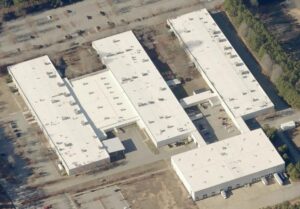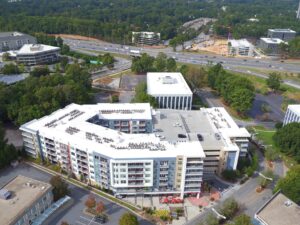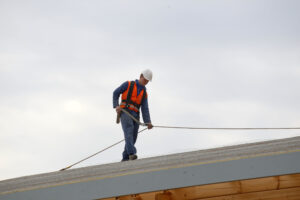by Connor | Mar 28, 2022 | Roofing

Due to their positioning, roofs are exposed to extreme temperatures and sometimes harsh weather. This may result in cracks caused by stresses in the waterproofing layer. Waterproofing is required to provide safety, and it is vital to use products characterized by considerable elasticity and high UV resistance.
TPO is the intelligent roofing solution for eco-friendly light-colored roofs that combine pleasing aesthetics with outstanding protection from ultraviolet radiation and weather, along with exceptional joint strength.
TPO is a membrane that offers a variety of installation options for low-slope roof renovation and construction projects.
For licensed and top rated TPO roofing Atlanta contractors, installing this type of roof is not difficult. It can be done mechanically (the membrane is secured using screws and plates), with ballast, or using tar mopping or a liquid adhesive. Installation can be performed in any season and various weather conditions. The last step of installing TPO roofing properly involves using a hot-air gun to weld the seams together.
Specialists also use a full range of accessories for these roofing systems, which meet the construction and installation requirements. Thus, building owners benefit from all the components needed for a complete roof system. The right Atlanta contractors will have no issues installing a TPO roof properly.
by Connor | Mar 21, 2022 | Roofing

Aerial thermal imaging services with the help of drones equipped with special cameras are addressed to purposes other than standard filming and photography. The most frequent uses of drones with infrared cameras are related to rescue operations, search, inspecting installations, pipes, power lines, and even roofs.
According to Superior Commercial Roofing & Contracting professionals, drone and thermal roof inspections can be an extremely effective method of roof maintenance. Checking a roof is not easy because it involves working at height, so you need professional protective equipment. In addition, identifying problems with the roof (small cracks that allow water to seep in) is not easy to do with the naked eye, but a thermal imaging camera installed on a drone will do the job without any problems. Thermal scanning provides information on the percentage of roof sealing and areas that allow water infiltration, generating thermographic images.
Be careful. However, this method does not eliminate leaks but will only help to identify them! Once you know exactly where the problems are, the repairs will be more efficient, and they will extend the roof’s life span.
Drone and thermal roof inspections are a thing of the future and have meager costs compared to repairing or replacing roofs, so it is efficient to use them in the regular roof maintenance process. This way, you will prevent much more costly incidents.
by Connor | Mar 4, 2022 | Roofing

The ideal roof would be 100% reflective in summer and 100% absorbent in winter, but a roof cannot change its reflective and emission properties. As a result, the overall energy efficiency of a roof must be assessed by comparing the energy saved from temperature regulation during the hot summer months with the energy consumed in the cold season.
TPO membranes – Roof systems that reflect the sun’s rays can save energy and money. They are suitable year round in warm environments, in the hot summer months, and in temperate areas. Reflective roofs are metallic or very light colored, and TPO membranes are typically white or light gray.
In addition to reducing the cooling demand for the entire building, a low roof temperature also increases the efficiency of the installed photovoltaic system. Where there is a HVAC system installed, the efficiency of transporting cold air throughout the building is also dramatically increased. According to flat roofing Atlanta experts, this leads to low energy consumption, an environmentally friendly impact.
PVC membranes can be manufactured in light gray or slate gray, so they have similar properties to TPO membranes when it comes to energy efficiency. Their advantage is better resistance to very high temperatures.
EPDM membranes are dark in color, making them suitable for cold areas with less sunshine. Energy efficiency can still be achieved when they are installed in sunny areas by covering them with a layer of white liquid coating. This will also deliver additional protection.
by Connor | Feb 28, 2022 | Roofing

Flat roofs require a pliable, waterproof cover material that performs well in circumstances where shingles and tiles don’t. Rubber is the most popular flat roof covering option. EPDM, PVC and TPO membranes are the best options in this category for the following reasons:
EPDM membranes
- According to economical EPDM roofing Atlanta contractors, this membrane provides excellent stability against weathering, sun exposure, acids and caustic solutions
- Long-lasting flexibility and elasticity
- Traction resistant
- Easy to apply, partly because they can be manufactured in large dimensions (up to 15m width and 60m length)
- No additional mechanical fastening required
- Unlimited aging resistance – this membrane does not contain plasticizers or antioxidants that would make it susceptible to migration or degradation
- Chemically inert – the composition of the membrane remains constant because it is vulcanized
- More environmentally friendly than other waterproofing materials
- Compatibility with green roofs (root resistance) and photovoltaic systems
PVC membranes
- Used for over 50 years
- Strong fire resistance
- Customized architectural solutions available (colors, profiles and roof logos)
- Suitable for different climatic conditions
- Quick installation independent of the weather (PVC membranes can be installed even in low temperatures or when it rains)
- Vapor permeability
- Great flexibility
TPO membranes
- High chemical resistance
- Suitable for direct application on substrates such as bitumen, EPS insulation, and XPS (polystyrene)
- No plasticizer (no migration/contamination, or perspiration)
- Long lifespan
- Easy maintenance
- Easy handling and installation (no need for fire sources)
- Resistance to severe weather conditions
- Environmentally friendly
by Connor | Feb 21, 2022 | Roofing

The acronym TPO stands for thermoplastic polyolefin, a material originally developed for pond liners and widely used for roofing since the 1980s. It is a single-ply membrane made of a polymerized combination of polypropylene and ethylene-propylene rubber that can be attached to a roof with adhesive or mechanical fasteners.
According to affordable rubber roofing Atlanta contractors, this material is a cheap and efficient choice, and is excellent for large buildings in the Atlanta area because it is designed for flat and low slope roofs. TPO is produced by pouring ethylene propylene rubber into a matrix reinforced with polyester fabrics. The hardened membrane perfectly combines weather resistance with the good heat welding capacity of the plastic, resulting in flexible sheets with an extremely good flatness.
TPO membrane is also very easy to install, ensuring economical and fast roof covering.
The exposed surface is usually reflective white, which makes TPO membranes suitable in Atlanta’s humid subtropical climates, contributing to the energy efficiency of the building- it is well known that white and very light shades reflect the sun, so the roof will not absorb the heat. This roofing material can also be easily recycled. All these ecological advantages make TPO membrane a good choice for all your roofing projects.
by Connor | Feb 14, 2022 | Roofing

Any roofing project requires planning, even more so larger commercial projects. Without planning, the likelihood of being successful is slim and your precious investments will be at high risk.
The roofing project must begin by verifying the available funds and collecting information and specifications about the roof. Project development comes next, with identifying the stakeholders in the project, planning site access, protection, and communication.
There will also be some other pre-construction activities that may include sending documents, setting up subcontractors etc., and then the actual work can start.
In order to prevent mistakes, delays, the use of incorrect materials, and compromised quality, a large commercial roofing project must be supervised closely by a knowledgeable Atlanta commercial roofing contractor during each stage. This way, problems can be identified in time to carry out preventive and corrective measures.
As a commercial building owner or administrator, you must realize that your communication with the roofing contractor throughout the project is essential. Therefore, you must be able to establish contact whenever you have queries or concerns. You are fully entitled to expect your contractor to be available, and be able to prove that the work is going according to the contract you signed.






